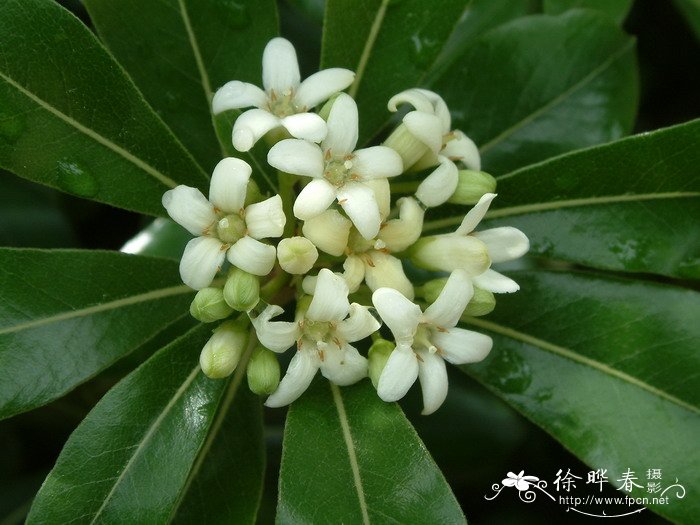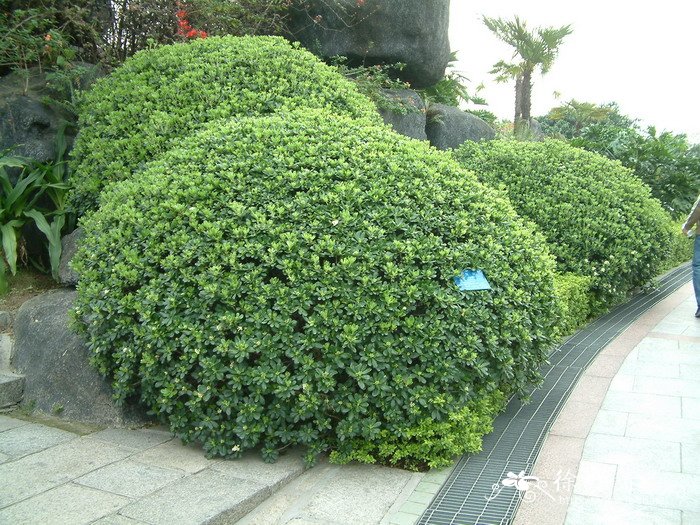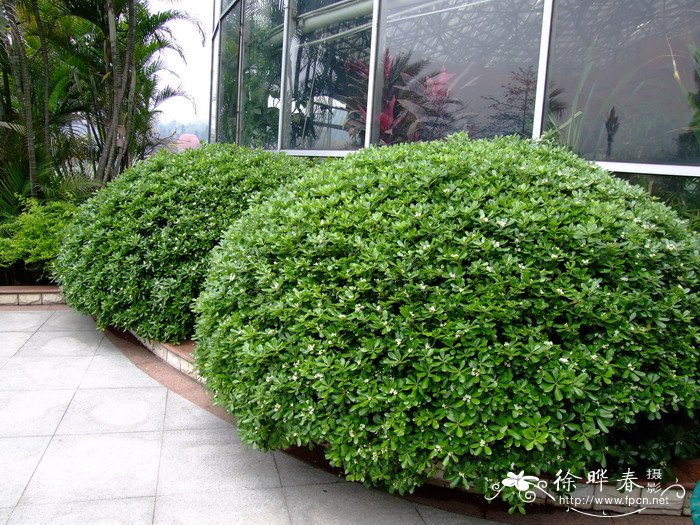海桐Pittosporum tobira
中文名(Chinese Name):海桐
学名(Scientific Name):Pittosporum tobira (Thunb.) W.T. Aiton
英文名(English Common Name):Japanese cheesewood
别名(Chinese Common Name):
异名(Synonym):Pittosporum tobira var. chinense S. Kobay. Euonymus tobira Thunb.
科属(Family & Genus):海桐花科(Pittosporaceae)海桐花属
形态特征(Description):常绿灌木或小乔木,高达6米,嫩枝被褐色柔毛,有皮孔。叶聚生于枝顶,二年生,革质,嫩时上下两面有柔毛,以后变秃净,倒卵形或倒卵状披针形,长4-9厘米,宽1.5-4厘米,上面深绿色,发亮、干后暗晦无光,先端圆形或钝,常微凹入或为微心形,基部窄楔形,侧脉6-8对,在靠近边缘处相结合,有时因侧脉间的支脉较明显而呈多脉状,网脉稍明显,网眼细小,全缘,干后反卷,叶柄长达2厘米。伞形花序或伞房状伞形花序顶生或近顶生,密被黄褐色柔毛,花梗长1-2厘米;苞片披针形,长4-5毫米;小苞片长2-3毫米,均被褐毛。花白色,有芳香,后变黄色;萼片卵形,长3-4毫米,被柔毛;花瓣倒披针形,长1-1.2厘米,离生;雄蕊2型,退化雄蕊的花丝长2-3毫米,花药近于不育;正常雄蕊的花丝长5-6毫米,花药长圆形,长2毫米,黄色;子房长卵形,密被柔毛,侧膜胎座3个,胚珠多数,2列着生于胎座中段。蒴果圆球形,有棱或呈三角形,直径12毫米,多少有毛,子房柄长1-2毫米,3片裂开,果片木质,厚1.5毫米,内侧黄褐色,有光泽,具横格;种子多数,长4毫米,多角形,红色,种柄长约2毫米。
分布(Distribution):分布于长江以南滨海各省,内地多为栽培供观赏;亦见于日本及朝鲜。
用途(Use):
引自中国植物志英文版:FOC Vol. 9 Page 4
Pittosporum tobira (Thunberg) W. T Aiton, Hortus Kew. 2: 27. 1811.
海桐 hai tong| Pittosporaceae | Pittosporum
Shrubs or small trees to 6 m tall. Young branchlets lenticellate. Leaves clustered at branchlet apex, biennial; petiole ca. 2 cm; leaf blade dark green and shiny adaxially, dull after drying, obovate or obovate-lanceolate, 4–9 × 1.5–4 cm, leathery, lateral veins 6–8-paired, connected at margin, sometimes reticulate veins conspicuous between lateral veins, base narrowly cuneate, margin entire, revolute, apex rounded or obtuse, usually emarginate or slightly cordate. Inflorescences terminal or near so, umbellate or corymbose; bracts lanceolate, 4–5 mm; bracteoles 2–3 mm; pedicels 1–2 cm; flowers fragrant. Sepals lanceolate, 3–4 mm. Petals free, white at first, becoming yellow later, oblanceolate, 1–1.2 cm. Stamens dimorphic: filament 2–3 mm and anther nearly sterile in reduced stamens; filament 5–6 mm and anther yellow, oblong, and ca. 2 mm in fertile stamens. Ovary long ovoid, densely pubescent; placentas 3; ovules numerous, in 2 rows. Capsule globose, angular, ca. 1.2 cm in diam., dehiscing by 3 valves, ± pubescent; pericarp yellow-brown and shiny adaxially, ca. 1.5 mm thick, woody, horizontally striate; stipe 1–2 mm. Seeds numerous, red, angular, ca. 4 mm; funicle ca. 2 mm. Fl. Mar–May, fr. May–Oct.
Cultivated for ornament and possibly naturalized, forests, limestone areas, slopes, sandy seashores, roadsides;; sea level to 1800 m. Native in N Taiwan; introduced in Fujian, Guangdong, Guangxi, Guizhou, Hainan, Hubei, Jiangsu, Sichuan, Taiwan, Yunnan, Zhejiang [native to S Japan and S Korea].


 (责任编辑:徐晔春)
(责任编辑:徐晔春)
学名(Scientific Name):Pittosporum tobira (Thunb.) W.T. Aiton
英文名(English Common Name):Japanese cheesewood
别名(Chinese Common Name):
异名(Synonym):Pittosporum tobira var. chinense S. Kobay. Euonymus tobira Thunb.
科属(Family & Genus):海桐花科(Pittosporaceae)海桐花属
形态特征(Description):常绿灌木或小乔木,高达6米,嫩枝被褐色柔毛,有皮孔。叶聚生于枝顶,二年生,革质,嫩时上下两面有柔毛,以后变秃净,倒卵形或倒卵状披针形,长4-9厘米,宽1.5-4厘米,上面深绿色,发亮、干后暗晦无光,先端圆形或钝,常微凹入或为微心形,基部窄楔形,侧脉6-8对,在靠近边缘处相结合,有时因侧脉间的支脉较明显而呈多脉状,网脉稍明显,网眼细小,全缘,干后反卷,叶柄长达2厘米。伞形花序或伞房状伞形花序顶生或近顶生,密被黄褐色柔毛,花梗长1-2厘米;苞片披针形,长4-5毫米;小苞片长2-3毫米,均被褐毛。花白色,有芳香,后变黄色;萼片卵形,长3-4毫米,被柔毛;花瓣倒披针形,长1-1.2厘米,离生;雄蕊2型,退化雄蕊的花丝长2-3毫米,花药近于不育;正常雄蕊的花丝长5-6毫米,花药长圆形,长2毫米,黄色;子房长卵形,密被柔毛,侧膜胎座3个,胚珠多数,2列着生于胎座中段。蒴果圆球形,有棱或呈三角形,直径12毫米,多少有毛,子房柄长1-2毫米,3片裂开,果片木质,厚1.5毫米,内侧黄褐色,有光泽,具横格;种子多数,长4毫米,多角形,红色,种柄长约2毫米。
分布(Distribution):分布于长江以南滨海各省,内地多为栽培供观赏;亦见于日本及朝鲜。
用途(Use):
引自中国植物志英文版:FOC Vol. 9 Page 4
Pittosporum tobira (Thunberg) W. T Aiton, Hortus Kew. 2: 27. 1811.
海桐 hai tong| Pittosporaceae | Pittosporum
Shrubs or small trees to 6 m tall. Young branchlets lenticellate. Leaves clustered at branchlet apex, biennial; petiole ca. 2 cm; leaf blade dark green and shiny adaxially, dull after drying, obovate or obovate-lanceolate, 4–9 × 1.5–4 cm, leathery, lateral veins 6–8-paired, connected at margin, sometimes reticulate veins conspicuous between lateral veins, base narrowly cuneate, margin entire, revolute, apex rounded or obtuse, usually emarginate or slightly cordate. Inflorescences terminal or near so, umbellate or corymbose; bracts lanceolate, 4–5 mm; bracteoles 2–3 mm; pedicels 1–2 cm; flowers fragrant. Sepals lanceolate, 3–4 mm. Petals free, white at first, becoming yellow later, oblanceolate, 1–1.2 cm. Stamens dimorphic: filament 2–3 mm and anther nearly sterile in reduced stamens; filament 5–6 mm and anther yellow, oblong, and ca. 2 mm in fertile stamens. Ovary long ovoid, densely pubescent; placentas 3; ovules numerous, in 2 rows. Capsule globose, angular, ca. 1.2 cm in diam., dehiscing by 3 valves, ± pubescent; pericarp yellow-brown and shiny adaxially, ca. 1.5 mm thick, woody, horizontally striate; stipe 1–2 mm. Seeds numerous, red, angular, ca. 4 mm; funicle ca. 2 mm. Fl. Mar–May, fr. May–Oct.
Cultivated for ornament and possibly naturalized, forests, limestone areas, slopes, sandy seashores, roadsides;; sea level to 1800 m. Native in N Taiwan; introduced in Fujian, Guangdong, Guangxi, Guizhou, Hainan, Hubei, Jiangsu, Sichuan, Taiwan, Yunnan, Zhejiang [native to S Japan and S Korea].
踩一下[1]

顶一下[5]